Financial Accounting Report: Principles, Stakeholders, and Statements
VerifiedAdded on 2021/02/21
|27
|4954
|48
Report
AI Summary
This report delves into the core principles of financial accounting, emphasizing its purpose in recording, summarizing, and reporting business transactions. It explores the roles of internal and external stakeholders and their interests in financial information. The report includes practical applications through client case studies, demonstrating the preparation of journal entries, trial balances, profit and loss statements, and balance sheets. It covers crucial accounting concepts like consistency and prudence, along with topics such as depreciation, bank reconciliation, and control accounts. The document also differentiates between limited companies and sole traders, offering a comprehensive overview of financial accounting practices and their significance in decision-making.
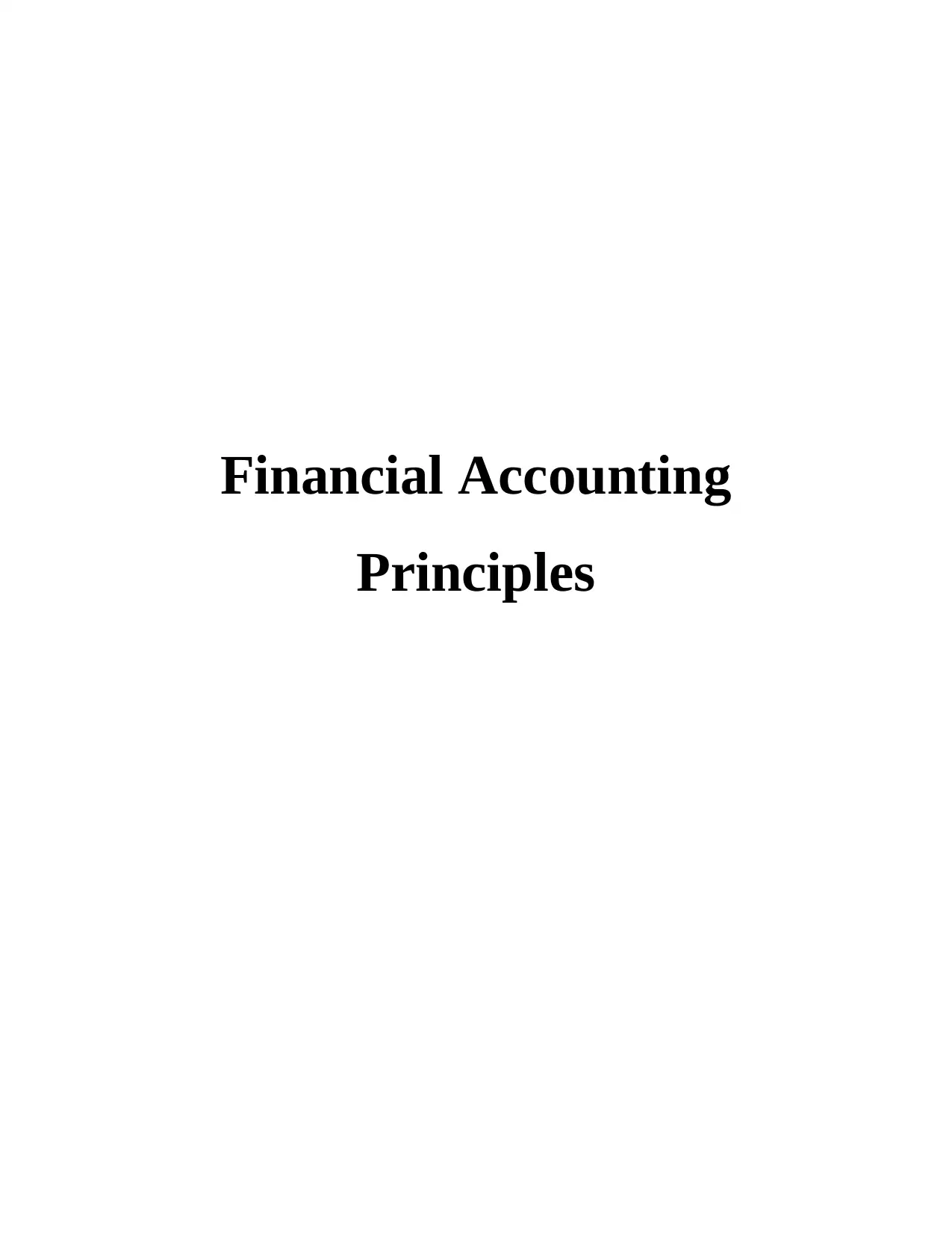
Financial Accounting
Principles
Principles
Paraphrase This Document
Need a fresh take? Get an instant paraphrase of this document with our AI Paraphraser

Table of Contents
INTRODUCTION...........................................................................................................................4
Part A...............................................................................................................................................4
Define financial accounting and its purposes..............................................................................4
Two internal and four external stakeholders of a large organisation and the reason behind their
interest in the financial information of a company......................................................................6
Part B...............................................................................................................................................7
Client 1.............................................................................................................................................7
a.) Recording journal entries........................................................................................................7
b.) Preparation of Trial balance.................................................................................................15
Client 2...........................................................................................................................................16
a.) Profits and loss statement.....................................................................................................16
b.) Financial position statement.................................................................................................16
c.) Accounting concepts.............................................................................................................18
d.) Purpose of depreciation........................................................................................................18
e.) Distinguish between limited companies and Sole traders....................................................19
Client 3...........................................................................................................................................20
a.) Purpose of BRS....................................................................................................................20
b.) List of factors which vary the records..................................................................................20
c.) Assessment on term “Imprest”.............................................................................................21
d.) Cash book of Burcu Ltd.......................................................................................................21
Client 4...........................................................................................................................................23
a.) Preparation of control account..............................................................................................23
b.) Explanation on term Control account...................................................................................24
Client 5...........................................................................................................................................24
a.) Assessment on term “Suspense account”.............................................................................24
b.) Trial balance.........................................................................................................................25
c.) Rectification of errors in trial balance..................................................................................25
CONCLUSION..............................................................................................................................26
REFERENCES................................................................................................................................1
INTRODUCTION...........................................................................................................................4
Part A...............................................................................................................................................4
Define financial accounting and its purposes..............................................................................4
Two internal and four external stakeholders of a large organisation and the reason behind their
interest in the financial information of a company......................................................................6
Part B...............................................................................................................................................7
Client 1.............................................................................................................................................7
a.) Recording journal entries........................................................................................................7
b.) Preparation of Trial balance.................................................................................................15
Client 2...........................................................................................................................................16
a.) Profits and loss statement.....................................................................................................16
b.) Financial position statement.................................................................................................16
c.) Accounting concepts.............................................................................................................18
d.) Purpose of depreciation........................................................................................................18
e.) Distinguish between limited companies and Sole traders....................................................19
Client 3...........................................................................................................................................20
a.) Purpose of BRS....................................................................................................................20
b.) List of factors which vary the records..................................................................................20
c.) Assessment on term “Imprest”.............................................................................................21
d.) Cash book of Burcu Ltd.......................................................................................................21
Client 4...........................................................................................................................................23
a.) Preparation of control account..............................................................................................23
b.) Explanation on term Control account...................................................................................24
Client 5...........................................................................................................................................24
a.) Assessment on term “Suspense account”.............................................................................24
b.) Trial balance.........................................................................................................................25
c.) Rectification of errors in trial balance..................................................................................25
CONCLUSION..............................................................................................................................26
REFERENCES................................................................................................................................1

⊘ This is a preview!⊘
Do you want full access?
Subscribe today to unlock all pages.

Trusted by 1+ million students worldwide
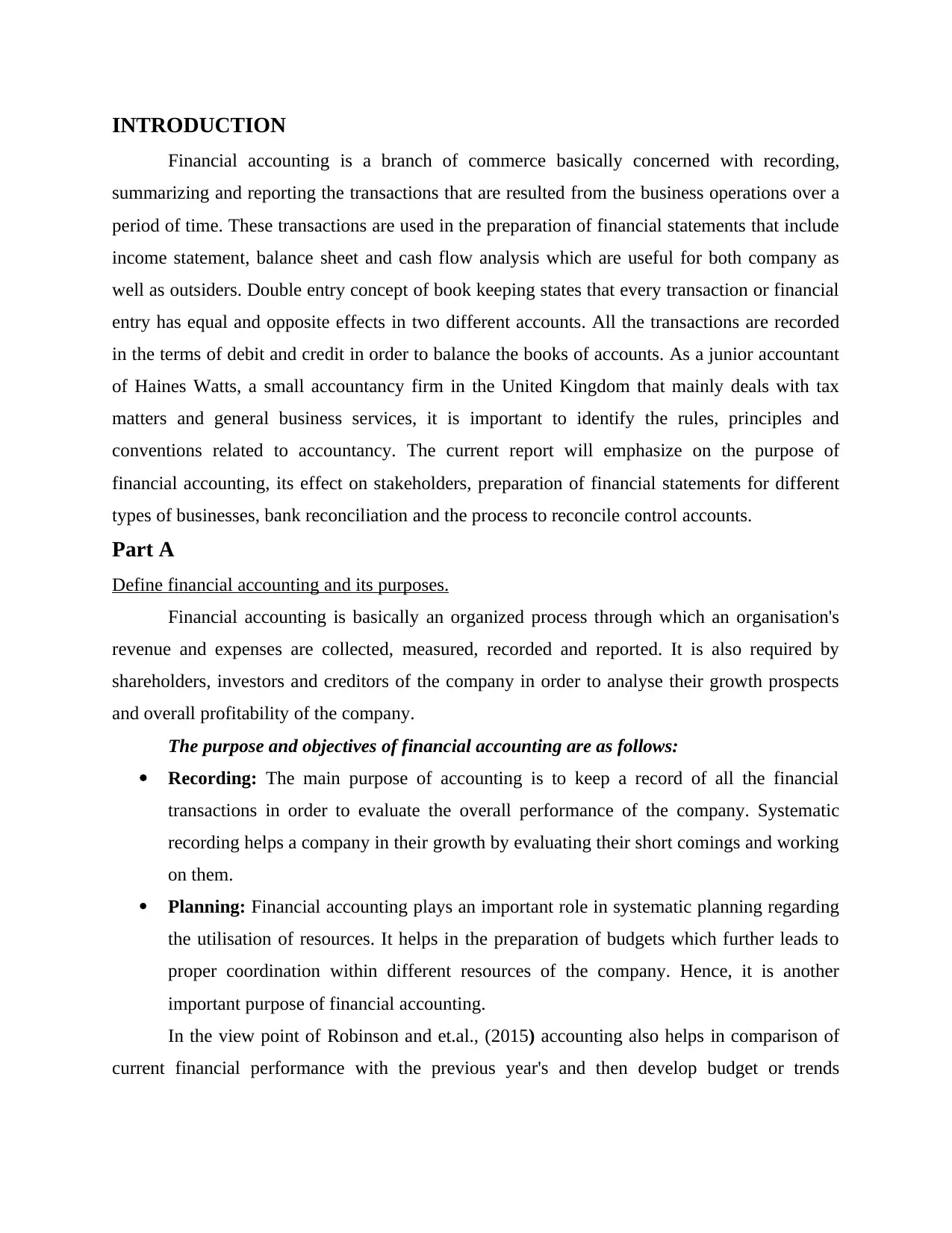
INTRODUCTION
Financial accounting is a branch of commerce basically concerned with recording,
summarizing and reporting the transactions that are resulted from the business operations over a
period of time. These transactions are used in the preparation of financial statements that include
income statement, balance sheet and cash flow analysis which are useful for both company as
well as outsiders. Double entry concept of book keeping states that every transaction or financial
entry has equal and opposite effects in two different accounts. All the transactions are recorded
in the terms of debit and credit in order to balance the books of accounts. As a junior accountant
of Haines Watts, a small accountancy firm in the United Kingdom that mainly deals with tax
matters and general business services, it is important to identify the rules, principles and
conventions related to accountancy. The current report will emphasize on the purpose of
financial accounting, its effect on stakeholders, preparation of financial statements for different
types of businesses, bank reconciliation and the process to reconcile control accounts.
Part A
Define financial accounting and its purposes.
Financial accounting is basically an organized process through which an organisation's
revenue and expenses are collected, measured, recorded and reported. It is also required by
shareholders, investors and creditors of the company in order to analyse their growth prospects
and overall profitability of the company.
The purpose and objectives of financial accounting are as follows:
Recording: The main purpose of accounting is to keep a record of all the financial
transactions in order to evaluate the overall performance of the company. Systematic
recording helps a company in their growth by evaluating their short comings and working
on them.
Planning: Financial accounting plays an important role in systematic planning regarding
the utilisation of resources. It helps in the preparation of budgets which further leads to
proper coordination within different resources of the company. Hence, it is another
important purpose of financial accounting.
In the view point of Robinson and et.al., (2015) accounting also helps in comparison of
current financial performance with the previous year's and then develop budget or trends
Financial accounting is a branch of commerce basically concerned with recording,
summarizing and reporting the transactions that are resulted from the business operations over a
period of time. These transactions are used in the preparation of financial statements that include
income statement, balance sheet and cash flow analysis which are useful for both company as
well as outsiders. Double entry concept of book keeping states that every transaction or financial
entry has equal and opposite effects in two different accounts. All the transactions are recorded
in the terms of debit and credit in order to balance the books of accounts. As a junior accountant
of Haines Watts, a small accountancy firm in the United Kingdom that mainly deals with tax
matters and general business services, it is important to identify the rules, principles and
conventions related to accountancy. The current report will emphasize on the purpose of
financial accounting, its effect on stakeholders, preparation of financial statements for different
types of businesses, bank reconciliation and the process to reconcile control accounts.
Part A
Define financial accounting and its purposes.
Financial accounting is basically an organized process through which an organisation's
revenue and expenses are collected, measured, recorded and reported. It is also required by
shareholders, investors and creditors of the company in order to analyse their growth prospects
and overall profitability of the company.
The purpose and objectives of financial accounting are as follows:
Recording: The main purpose of accounting is to keep a record of all the financial
transactions in order to evaluate the overall performance of the company. Systematic
recording helps a company in their growth by evaluating their short comings and working
on them.
Planning: Financial accounting plays an important role in systematic planning regarding
the utilisation of resources. It helps in the preparation of budgets which further leads to
proper coordination within different resources of the company. Hence, it is another
important purpose of financial accounting.
In the view point of Robinson and et.al., (2015) accounting also helps in comparison of
current financial performance with the previous year's and then develop budget or trends
Paraphrase This Document
Need a fresh take? Get an instant paraphrase of this document with our AI Paraphraser
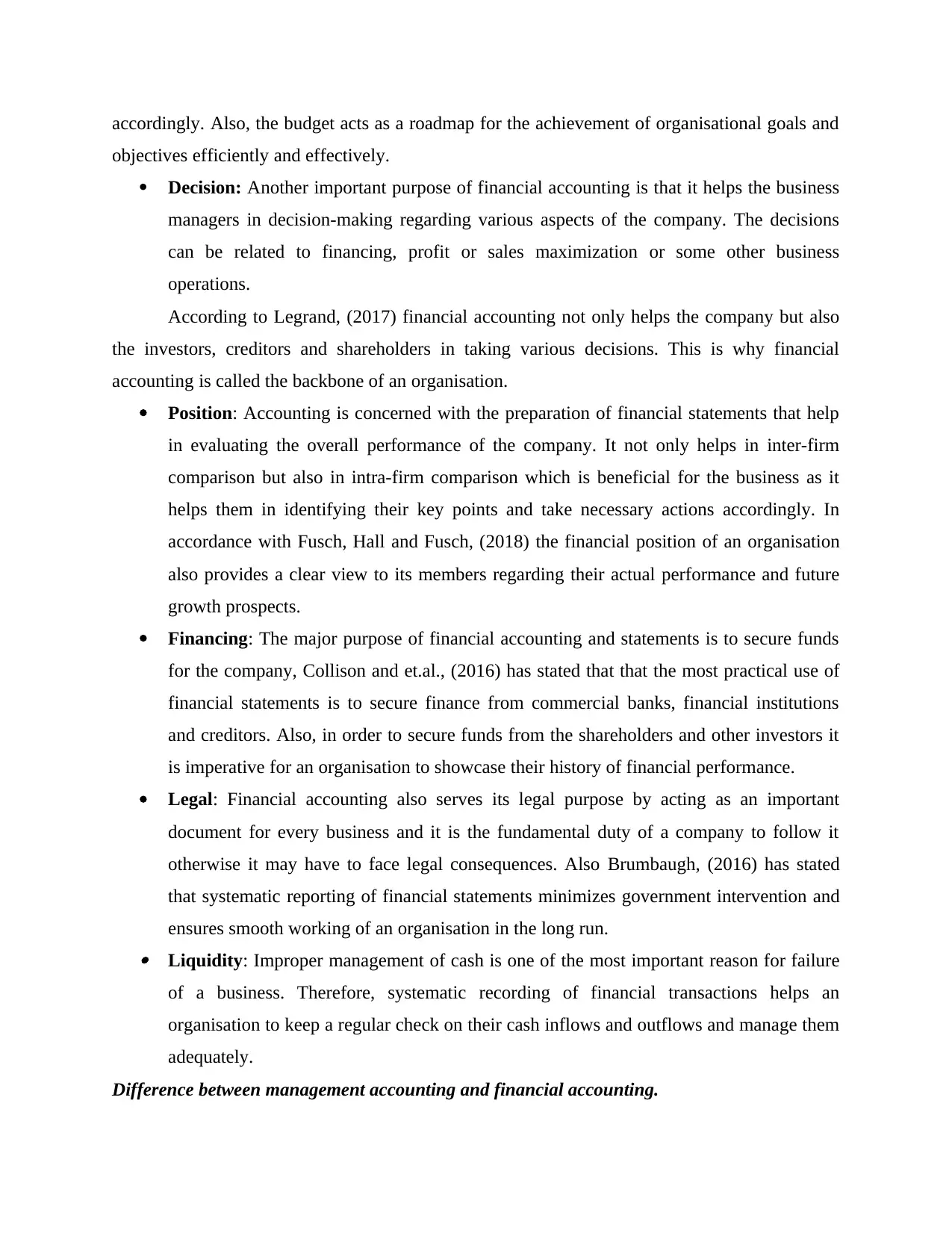
accordingly. Also, the budget acts as a roadmap for the achievement of organisational goals and
objectives efficiently and effectively.
Decision: Another important purpose of financial accounting is that it helps the business
managers in decision-making regarding various aspects of the company. The decisions
can be related to financing, profit or sales maximization or some other business
operations.
According to Legrand, (2017) financial accounting not only helps the company but also
the investors, creditors and shareholders in taking various decisions. This is why financial
accounting is called the backbone of an organisation.
Position: Accounting is concerned with the preparation of financial statements that help
in evaluating the overall performance of the company. It not only helps in inter-firm
comparison but also in intra-firm comparison which is beneficial for the business as it
helps them in identifying their key points and take necessary actions accordingly. In
accordance with Fusch, Hall and Fusch, (2018) the financial position of an organisation
also provides a clear view to its members regarding their actual performance and future
growth prospects.
Financing: The major purpose of financial accounting and statements is to secure funds
for the company, Collison and et.al., (2016) has stated that that the most practical use of
financial statements is to secure finance from commercial banks, financial institutions
and creditors. Also, in order to secure funds from the shareholders and other investors it
is imperative for an organisation to showcase their history of financial performance.
Legal: Financial accounting also serves its legal purpose by acting as an important
document for every business and it is the fundamental duty of a company to follow it
otherwise it may have to face legal consequences. Also Brumbaugh, (2016) has stated
that systematic reporting of financial statements minimizes government intervention and
ensures smooth working of an organisation in the long run. Liquidity: Improper management of cash is one of the most important reason for failure
of a business. Therefore, systematic recording of financial transactions helps an
organisation to keep a regular check on their cash inflows and outflows and manage them
adequately.
Difference between management accounting and financial accounting.
objectives efficiently and effectively.
Decision: Another important purpose of financial accounting is that it helps the business
managers in decision-making regarding various aspects of the company. The decisions
can be related to financing, profit or sales maximization or some other business
operations.
According to Legrand, (2017) financial accounting not only helps the company but also
the investors, creditors and shareholders in taking various decisions. This is why financial
accounting is called the backbone of an organisation.
Position: Accounting is concerned with the preparation of financial statements that help
in evaluating the overall performance of the company. It not only helps in inter-firm
comparison but also in intra-firm comparison which is beneficial for the business as it
helps them in identifying their key points and take necessary actions accordingly. In
accordance with Fusch, Hall and Fusch, (2018) the financial position of an organisation
also provides a clear view to its members regarding their actual performance and future
growth prospects.
Financing: The major purpose of financial accounting and statements is to secure funds
for the company, Collison and et.al., (2016) has stated that that the most practical use of
financial statements is to secure finance from commercial banks, financial institutions
and creditors. Also, in order to secure funds from the shareholders and other investors it
is imperative for an organisation to showcase their history of financial performance.
Legal: Financial accounting also serves its legal purpose by acting as an important
document for every business and it is the fundamental duty of a company to follow it
otherwise it may have to face legal consequences. Also Brumbaugh, (2016) has stated
that systematic reporting of financial statements minimizes government intervention and
ensures smooth working of an organisation in the long run. Liquidity: Improper management of cash is one of the most important reason for failure
of a business. Therefore, systematic recording of financial transactions helps an
organisation to keep a regular check on their cash inflows and outflows and manage them
adequately.
Difference between management accounting and financial accounting.
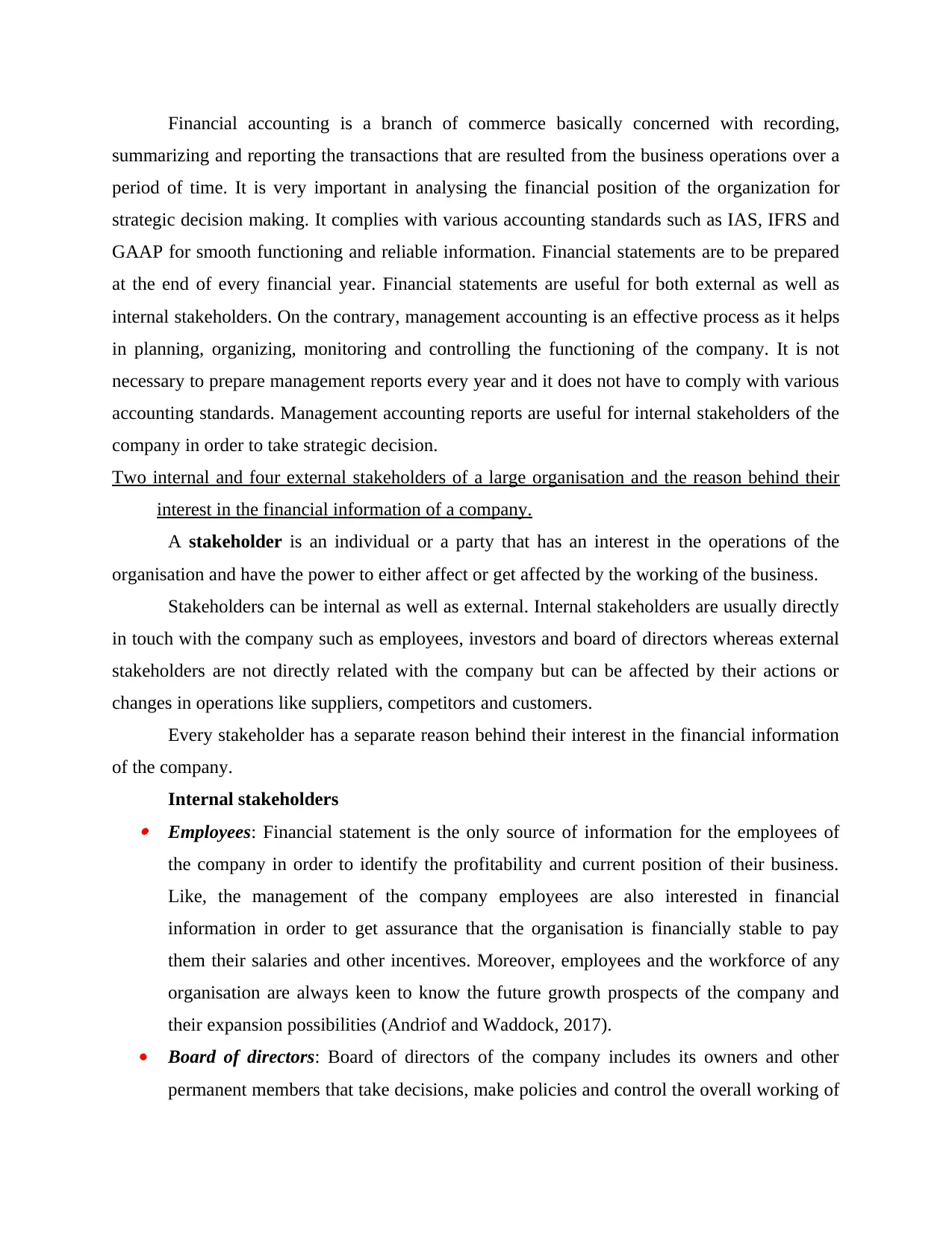
Financial accounting is a branch of commerce basically concerned with recording,
summarizing and reporting the transactions that are resulted from the business operations over a
period of time. It is very important in analysing the financial position of the organization for
strategic decision making. It complies with various accounting standards such as IAS, IFRS and
GAAP for smooth functioning and reliable information. Financial statements are to be prepared
at the end of every financial year. Financial statements are useful for both external as well as
internal stakeholders. On the contrary, management accounting is an effective process as it helps
in planning, organizing, monitoring and controlling the functioning of the company. It is not
necessary to prepare management reports every year and it does not have to comply with various
accounting standards. Management accounting reports are useful for internal stakeholders of the
company in order to take strategic decision.
Two internal and four external stakeholders of a large organisation and the reason behind their
interest in the financial information of a company.
A stakeholder is an individual or a party that has an interest in the operations of the
organisation and have the power to either affect or get affected by the working of the business.
Stakeholders can be internal as well as external. Internal stakeholders are usually directly
in touch with the company such as employees, investors and board of directors whereas external
stakeholders are not directly related with the company but can be affected by their actions or
changes in operations like suppliers, competitors and customers.
Every stakeholder has a separate reason behind their interest in the financial information
of the company.
Internal stakeholders Employees: Financial statement is the only source of information for the employees of
the company in order to identify the profitability and current position of their business.
Like, the management of the company employees are also interested in financial
information in order to get assurance that the organisation is financially stable to pay
them their salaries and other incentives. Moreover, employees and the workforce of any
organisation are always keen to know the future growth prospects of the company and
their expansion possibilities (Andriof and Waddock, 2017).
Board of directors: Board of directors of the company includes its owners and other
permanent members that take decisions, make policies and control the overall working of
summarizing and reporting the transactions that are resulted from the business operations over a
period of time. It is very important in analysing the financial position of the organization for
strategic decision making. It complies with various accounting standards such as IAS, IFRS and
GAAP for smooth functioning and reliable information. Financial statements are to be prepared
at the end of every financial year. Financial statements are useful for both external as well as
internal stakeholders. On the contrary, management accounting is an effective process as it helps
in planning, organizing, monitoring and controlling the functioning of the company. It is not
necessary to prepare management reports every year and it does not have to comply with various
accounting standards. Management accounting reports are useful for internal stakeholders of the
company in order to take strategic decision.
Two internal and four external stakeholders of a large organisation and the reason behind their
interest in the financial information of a company.
A stakeholder is an individual or a party that has an interest in the operations of the
organisation and have the power to either affect or get affected by the working of the business.
Stakeholders can be internal as well as external. Internal stakeholders are usually directly
in touch with the company such as employees, investors and board of directors whereas external
stakeholders are not directly related with the company but can be affected by their actions or
changes in operations like suppliers, competitors and customers.
Every stakeholder has a separate reason behind their interest in the financial information
of the company.
Internal stakeholders Employees: Financial statement is the only source of information for the employees of
the company in order to identify the profitability and current position of their business.
Like, the management of the company employees are also interested in financial
information in order to get assurance that the organisation is financially stable to pay
them their salaries and other incentives. Moreover, employees and the workforce of any
organisation are always keen to know the future growth prospects of the company and
their expansion possibilities (Andriof and Waddock, 2017).
Board of directors: Board of directors of the company includes its owners and other
permanent members that take decisions, make policies and control the overall working of
⊘ This is a preview!⊘
Do you want full access?
Subscribe today to unlock all pages.

Trusted by 1+ million students worldwide
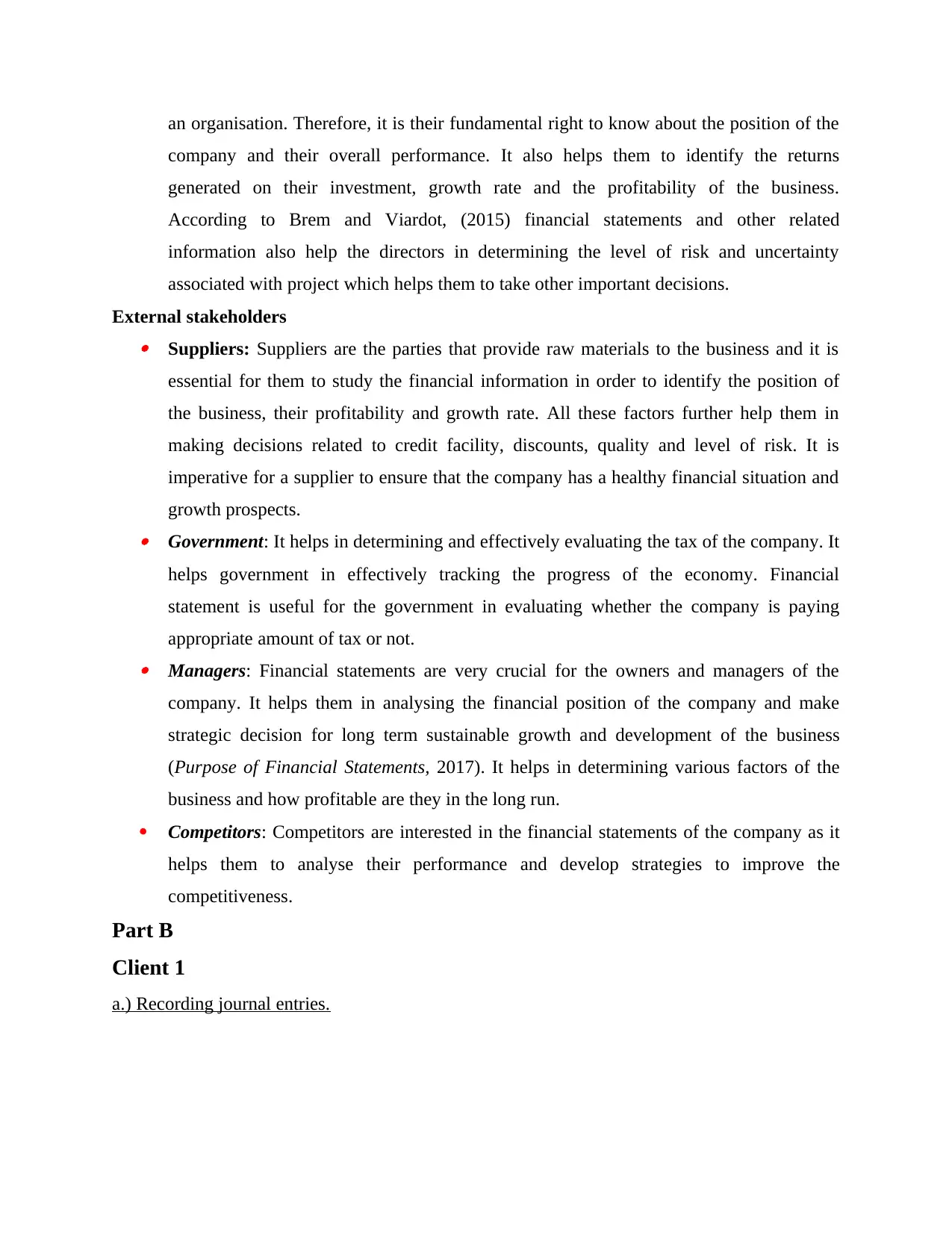
an organisation. Therefore, it is their fundamental right to know about the position of the
company and their overall performance. It also helps them to identify the returns
generated on their investment, growth rate and the profitability of the business.
According to Brem and Viardot, (2015) financial statements and other related
information also help the directors in determining the level of risk and uncertainty
associated with project which helps them to take other important decisions.
External stakeholders Suppliers: Suppliers are the parties that provide raw materials to the business and it is
essential for them to study the financial information in order to identify the position of
the business, their profitability and growth rate. All these factors further help them in
making decisions related to credit facility, discounts, quality and level of risk. It is
imperative for a supplier to ensure that the company has a healthy financial situation and
growth prospects. Government: It helps in determining and effectively evaluating the tax of the company. It
helps government in effectively tracking the progress of the economy. Financial
statement is useful for the government in evaluating whether the company is paying
appropriate amount of tax or not. Managers: Financial statements are very crucial for the owners and managers of the
company. It helps them in analysing the financial position of the company and make
strategic decision for long term sustainable growth and development of the business
(Purpose of Financial Statements, 2017). It helps in determining various factors of the
business and how profitable are they in the long run.
Competitors: Competitors are interested in the financial statements of the company as it
helps them to analyse their performance and develop strategies to improve the
competitiveness.
Part B
Client 1
a.) Recording journal entries.
company and their overall performance. It also helps them to identify the returns
generated on their investment, growth rate and the profitability of the business.
According to Brem and Viardot, (2015) financial statements and other related
information also help the directors in determining the level of risk and uncertainty
associated with project which helps them to take other important decisions.
External stakeholders Suppliers: Suppliers are the parties that provide raw materials to the business and it is
essential for them to study the financial information in order to identify the position of
the business, their profitability and growth rate. All these factors further help them in
making decisions related to credit facility, discounts, quality and level of risk. It is
imperative for a supplier to ensure that the company has a healthy financial situation and
growth prospects. Government: It helps in determining and effectively evaluating the tax of the company. It
helps government in effectively tracking the progress of the economy. Financial
statement is useful for the government in evaluating whether the company is paying
appropriate amount of tax or not. Managers: Financial statements are very crucial for the owners and managers of the
company. It helps them in analysing the financial position of the company and make
strategic decision for long term sustainable growth and development of the business
(Purpose of Financial Statements, 2017). It helps in determining various factors of the
business and how profitable are they in the long run.
Competitors: Competitors are interested in the financial statements of the company as it
helps them to analyse their performance and develop strategies to improve the
competitiveness.
Part B
Client 1
a.) Recording journal entries.
Paraphrase This Document
Need a fresh take? Get an instant paraphrase of this document with our AI Paraphraser
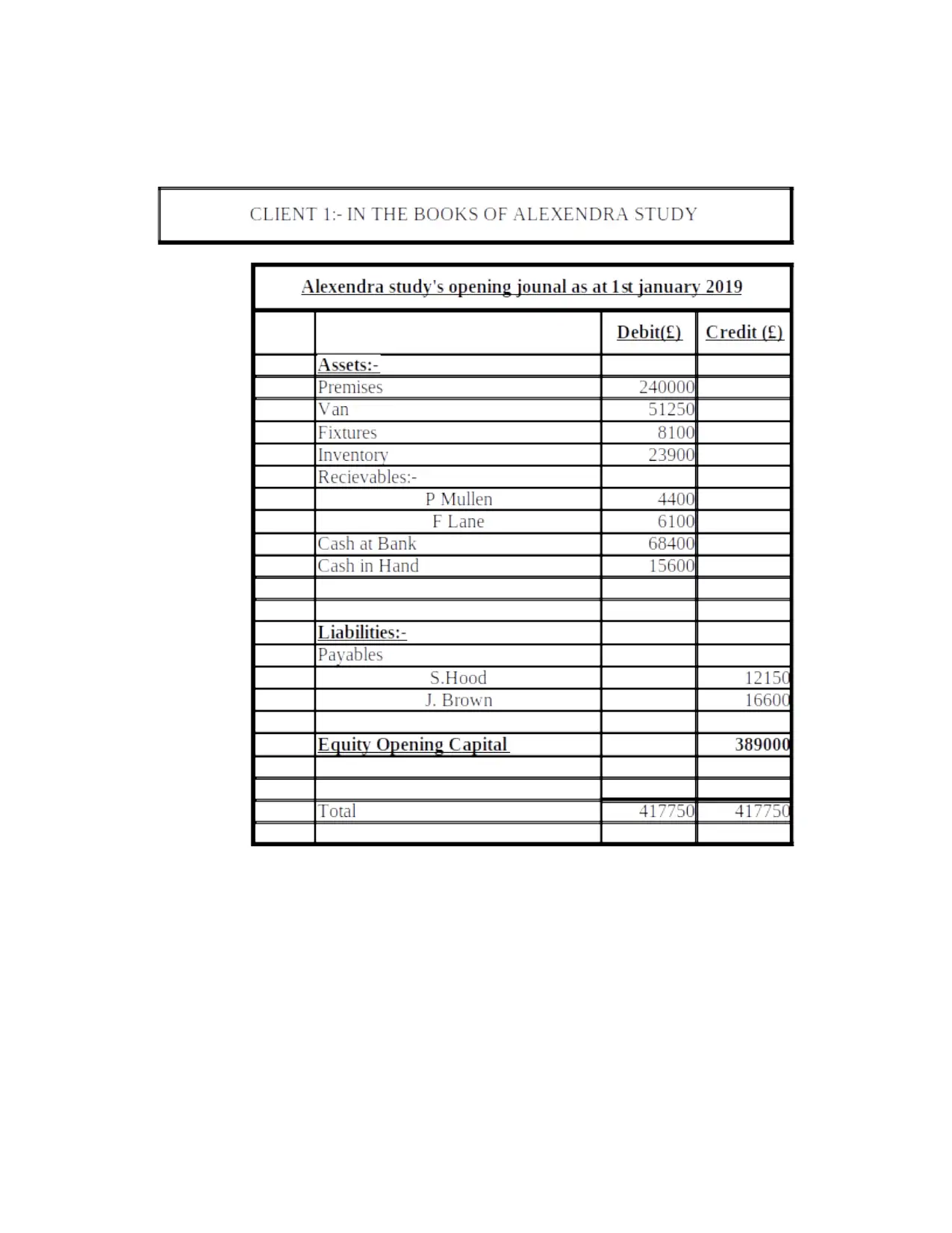
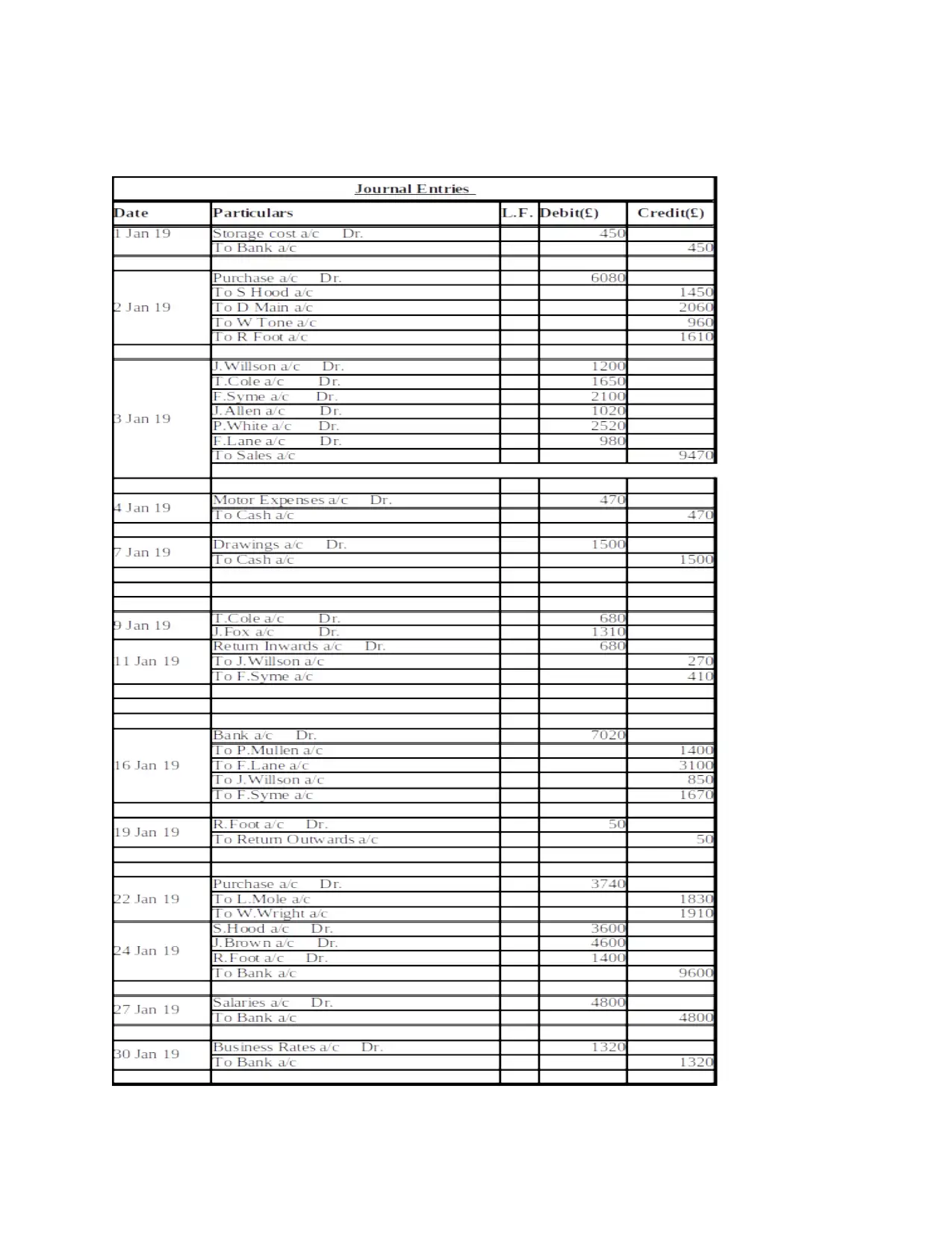
⊘ This is a preview!⊘
Do you want full access?
Subscribe today to unlock all pages.

Trusted by 1+ million students worldwide
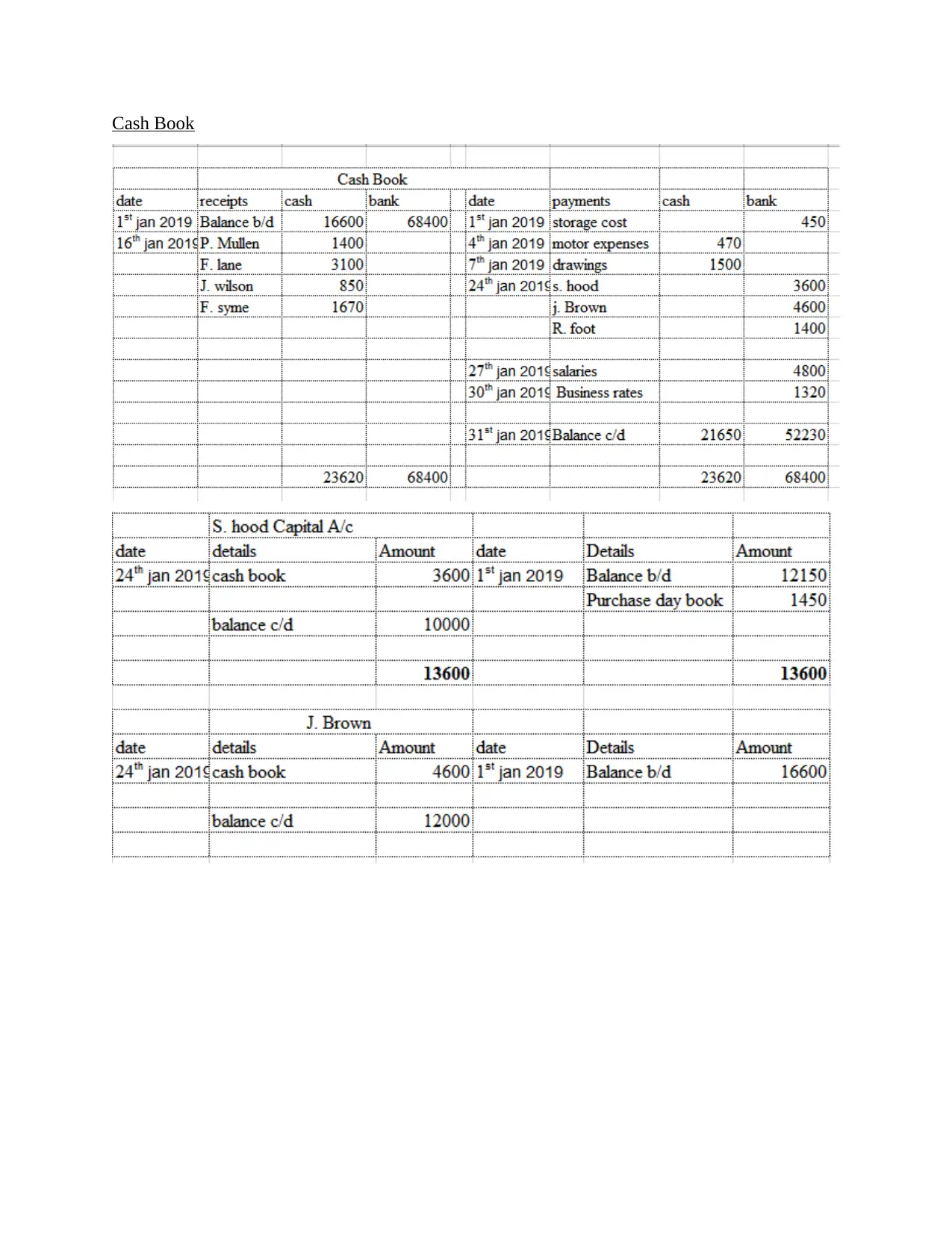
Cash Book
Paraphrase This Document
Need a fresh take? Get an instant paraphrase of this document with our AI Paraphraser
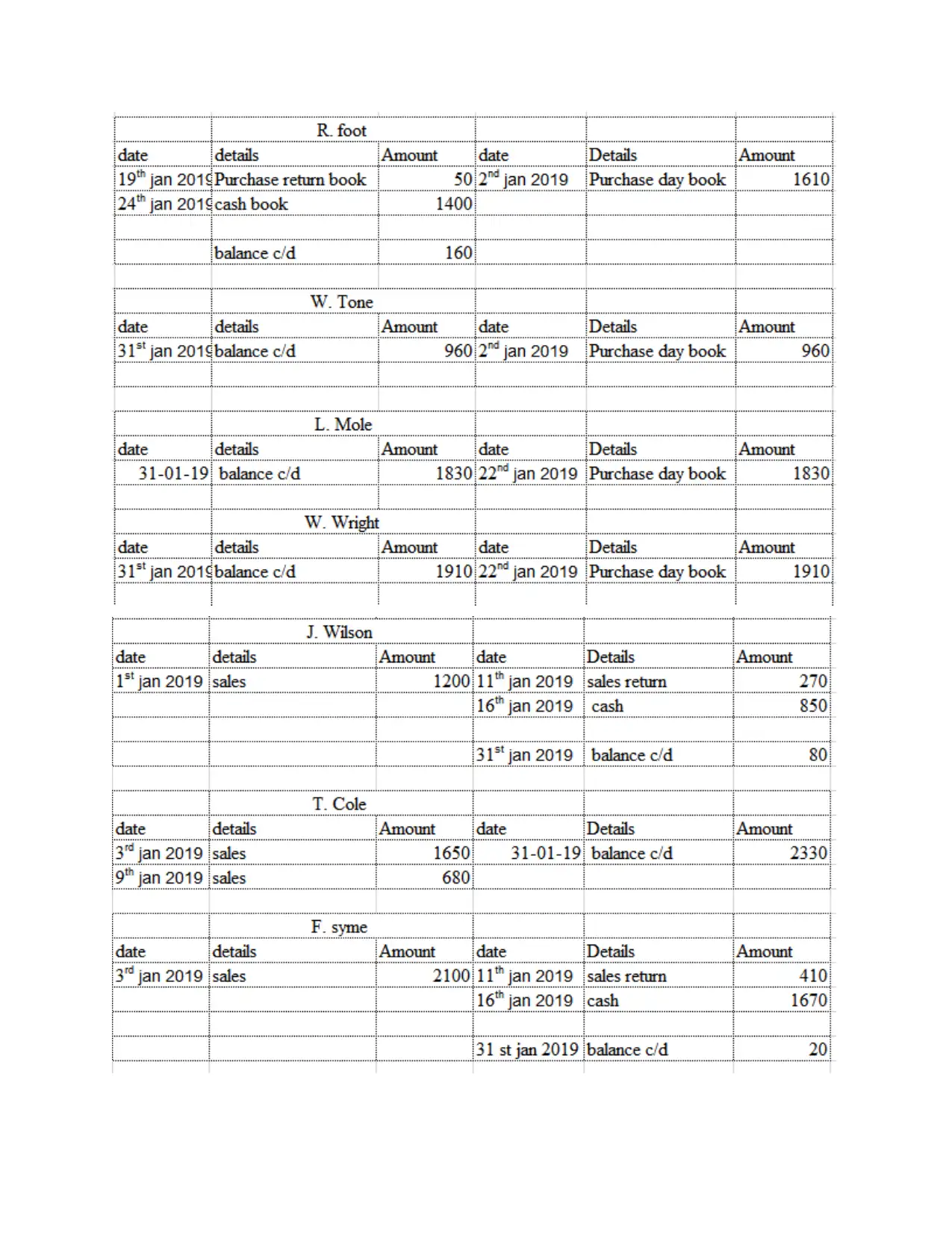

⊘ This is a preview!⊘
Do you want full access?
Subscribe today to unlock all pages.

Trusted by 1+ million students worldwide
1 out of 27
Related Documents
Your All-in-One AI-Powered Toolkit for Academic Success.
+13062052269
info@desklib.com
Available 24*7 on WhatsApp / Email
![[object Object]](/_next/static/media/star-bottom.7253800d.svg)
Unlock your academic potential
Copyright © 2020–2025 A2Z Services. All Rights Reserved. Developed and managed by ZUCOL.





